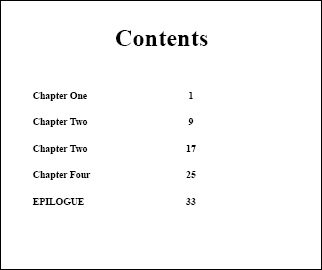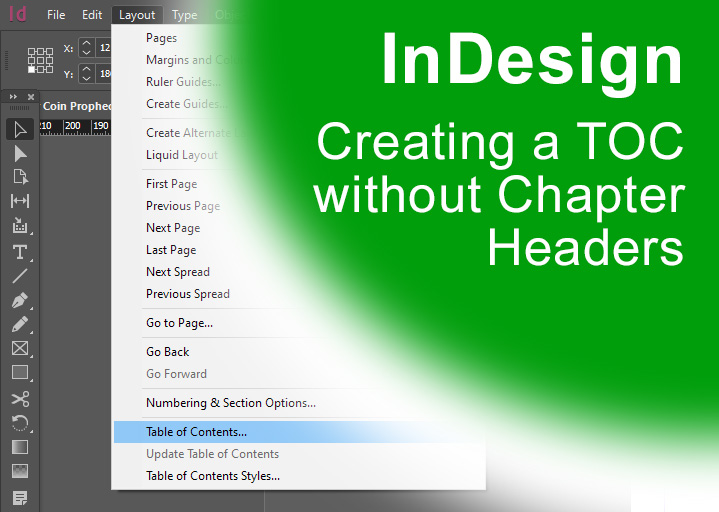


However, you can change this to some other character or characters. By default, InDesign places a tab character between the entry and the page number (whether the page number is before or after This way, all the page numbers appear the same rather than appearingįigure 8-10 More Table of Contents Optionsīetween Entry and Number. The Style pop-up menu to the right of the Page Number menu. We typically create a character style for the page numbers and select it from The text of the paragraph by a tab character. The first two tell InDesign to include the page number (either before or after the entry), separated from

You’ve got three options for numbering: After Entry, BeforeĮntry, and None. You can control how page numbers will appear on your printed page with the Page Number pop-up menu. Numbers after the headings, but not after the chapter titles in a book. You may not want every entry in your table of contents to be followed by a page number.

Lists we make we click the More Options button, which gives us more options for fine-tuning the table of contents (see Figure 8-10). The default Table of Contents dialog box gives you the basic controls you need for a simple table of contents, but for most (see Chapter 4, “Text,” if you need to know more about placing text). When it’s done, InDesign displays the text place icon, just as if you had imported a text file
Finally, when you click OK, InDesign builds the table of contents (which might take a little while, especially if you have. We’ll talk about the Replace Existing Table of Contents check box below. If your document is included in a Book panel, you can choose to include the entire book in your list by turning on the Includeīook Documents check box. InDesign addsĪ paragraph style called “TOC body text” to your document when you open this dialog box, but you don’t have to use it-we just If you wantĬertain paragraphs to be indented on your final list, you should apply styles here that include indentation. The actual Heading style instead, you’d probably create a new style called “TOC-head” or something like that. This is helpful because you’d rarely want a heading from your document to appear in your table of contents in One by one, click each style in the Include Paragraph Styles list and choose a paragraph style for it from the Entry Style. The order, just click and drag the style names after adding them). You can also select more than one style (by Command/Ctrl-clickingĮach one) and then click Add to add them all at once (in which case they’re added alphabetically-if you want to rearrange The list, but double-clicking the style names is faster. You can click the Add button to add them to Choose the paragraph styles that you want included from the list on the right. “TOC title” to your document when you open this dialog box, but you don’t have to use that style if you don’t want to.) (InDesign automatically adds a paragraph style called If you do include a title, choose a paragraph style for it from the Style pop-up menu to the right of the Title field. We usually leave this field blank and later make our To type “Table of Contents” or “Advertisers” or something like that. InDesign places this title at the beginning of the list, so you might want Fill in a name for your list in the Title field. We’ll cover table of contents styles later in this section. If you only have one list (table of contents, list of figures, etc.) in your document, you can leave the Style pop-up menu. Making a table of contents (or a list of figures, or whatever) is easy, but it requires a methodical approach to the Table Refer to Chapter 4, “Type,” to see why you should. You should be using styles anyway-if you’re not, you’re working way too hard This all depends entirely on your using styles. Styles, InDesign currently only works with paragraph styles.) Style, you can build into a “table of contents.” (While QuarkXPress can also make these kinds of lists based on character Tag your product names, you could just as easily build an index of products for a catalog. For instance, if you useĮven two styles when you’re formatting a book-one for the chapter name and another for your first-level headings-you can buildĪ basic table of contents by collecting all the paragraphs tagged with these two styles. This feature lets you build collections of paragraphs that have been tagged with specific styles. Don’t get fooled into thinking the Table of Contents feature (under the Layout menu) is only for making book tables of contents.








 0 kommentar(er)
0 kommentar(er)
